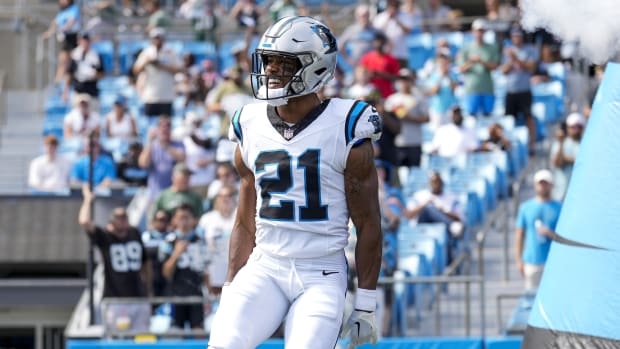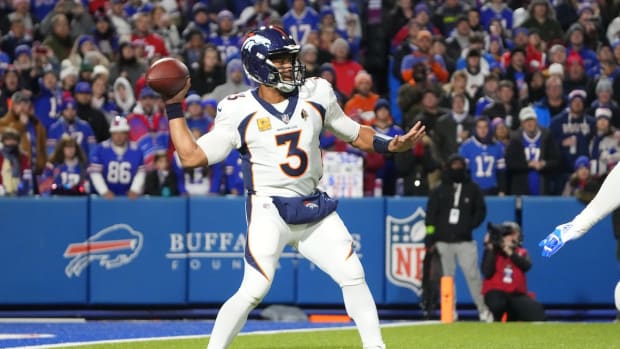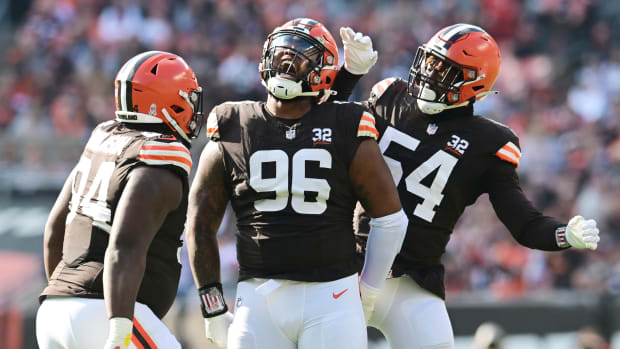From Day 3 to Day 1: Late-round NFL draft picks who could start in 2016
Get all of Doug Farrar’s columns as soon as they’re published. Download the new Sports Illustrated app (iOS or Android) and personalize your experience by following your favorite teams and SI writers.
Just because a player doesn’t hear his name announced until the third day of the NFL draft doesn’t mean he’s automatically knocked to the bottom of the depth chart in his rookie year. Last season, right tackle T.J. Clemmings started all 16 games for the Vikings despite being drafted in the fourth round. Outside linebacker Kwon Alexander started 12 games for the Buccaneers, refusing to let his own fourth-round status get in the way of his dreams. And how about Adrian Amos, the Bears’ safety, who started all 16 games as a fifth-rounder?
Third-round draft picks typically win a starting position due to a combination of sheer talent, opportunity and team need. With that in mind, here are six players who could find themselves with serious playing (and starting) time despite their third-day selection.
Paul Perkins, RB, Giants (fifth round, No. 149 overall, UCLA)
Perkins could be one of the steals of the 2016 draft class. The Giants haven’t had a 1,000-yard rusher since Ahmad Bradshaw in 2012, and the duo of Rashad Jennings and Andre Williams has been underwhelming. Adding Shane Vereen gives the offense more versatility, but none of these guys have the ability to juke defenders right out of their shoes on an alarmingly regular basis, like Perkins. The former UCLA player gained 3,488 yards and scored 29 rushing touchdowns in three seasons for the Bruins, and in 2015 alone he forced 73 missed tackles as a runner, per Pro Football Focus (only Alabama’s Derrick Henry had more). Perkins has power, and he’s a better blocker than many think, which makes him a potential every-down back in his first NFL season.
• MURPHY: How the draft’s first-round QBs stepped into spotlight
Kenneth Dixon, RB, Ravens (fourth round, No. 134 overall, Louisiana Tech)
Re-grading 2013 NFL draft classes, three years later
Dixon will start at the bottom of the Ravens’ running back depth chart, with Justin Forsett serving as Baltimore’s prohibitive starter and Buck Allen flashing some potential as a rookie last year. But the running back from Louisiana Tech adds a different element with his speed and power in the backfield and his ability as a receiver in space. When NFL teams look to scout players from smaller schools, they want to see absolute dominance against less-heralded opponents, and Dixon certainly qualifies—he scored 27 rushing touchdowns as a freshman, and improved as a player every season. Baltimore’s offense can use a younger back who can bring it in multiple ways, and Dixon, with his 5,452 total yards from scrimmage and 87 career touchdowns, appears to fit the bill.
Rashard Higgins, WR, Browns (fifth round, No. 172 overall, Colorado State)
Higgins didn’t blow anyone away with his combine numbers—players coming from smaller schools who run a 4.64 40 are probably going to slip down some boards, no matter how productive you were in college. But when you watch the tape, you see Higgins is an excellent route-runner, his drop rate is low, he can play outside or in the slot and he has an understanding of the little things that make young receivers productive. The Browns need all kinds of help at the receiver position, and while first-rounder Corey Coleman is the star right out of the gate, don’t be surprised if Higgins makes a name for himself early as well.
Pharoh Cooper, WR, Rams (fourth round, No. 117 overall, South Carolina)
After winning draft, AFC South set to shed loser reputation
Cooper excelled for the Gamecocks despite the fact that he had to adjust to a different starting quarterback every year, and with the exception of Connor Shaw in 2013, none of them were exceptional. And it didn't help that South Carolina’s offense fell apart last season. Still, Cooper was very productive in both 2014 and ’15, totaling 138 catches for 2,163 yards and 18 touchdowns. Hopefully, Jared Goff will put an end to the Rams’ long-time issues at the quarterback position, but if he doesn't early on, Cooper has proven that he can still succeed even with a passing offense that’s falling off a cliff.
Christian Westerman, OG, Bengals (fifth round, No. 161 overall, Arizona State)
Westerman starting would most likely take an unfortunate injury, since Bengals guards Clint Boling and Kevin Zeitler are two of the best in the business. But Westerman proved himself to be one of the better pass-blockers in college football last season, with just 15 total pressures allowed in 589 total pass-blocking snaps. He may have a future at center due to his size (6' 3", 298 pounds), but he’ll find a way to fit in somewhere.
• Eli Apple’s mom describes her emotional experience at NFL draft
Andrew Billings, DT, Bengals (fourth round, No. 122 overall, Baylor)
Billings is the only prospect drafted on the third day who made it on my SI 50 big board (I had him No. 23 overall), and I’m still trying to figure out why a guy who was an absolute wrecking machine for the Bears over three seasons lasted this long. In any case, the Bengals got a great deal here. Billings could replace Domata Peko in the short term, with the ability to fill in as a shorter leverage monster should Geno Atkins miss any time. He’s stout against the run, knifes through double teams and has the athleticism to drop into coverage for short passes and screens. His 5.5 sacks last season don’t tell the whole story—he led all collegiate interior defensive linemen in PFF’s Pass Rushing Productivity metric, with 30 total pressures in 371 total passing snaps.




































